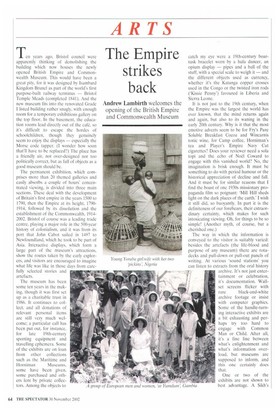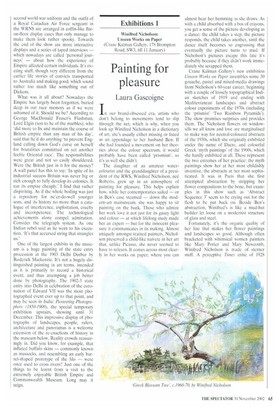The Empire strikes back
Andrew Lambirth welcomes the opening of the British Empire and Commonwealth Museum Ten years ago, Bristol council were apparently thinking of demolishing the building which now houses the newly opened British Empire and Commonwealth Museum. This would have been a great pity, for it was designed by Isambard Kingdom Brunel as part of the world's first purpose-built railway terminus — Bristol Temple Meads (completed 1841). And the new museum fits into the renovated Grade I listed building rather snugly, with enough room for a temporary exhibitions gallery on the top floor. In the basement, the education rooms lead directly out of the café, so it's difficult to escape the hordes of schoolchildren, though they genuinely seem to enjoy the displays — especially the Morse code tapper. (I wonder how soon that'll have to be replaced?) The place has a friendly air, not over-designed nor too politically correct, but as full of objects as a good museum should be.
The permanent exhibition, which comprises more than 20 themed galleries and easily absorbs a couple of hours' concentrated viewing, is divided into three main sections. These deal with the development of Britain's first empire in the years 1500 to 1790, then the Empire at its height, 17901914, followed by its dissolution and the establishment of the Commonwealth, 19142002. Bristol of course was a leading trade centre, playing a major role in the 500-year history of colonialism, and it was from its port that John Cabot sailed in 1497 to Newfoundland, which he took to be part of Asia. Interactive displays, which form a large part of the museum's attractions, show the routes taken by the early explorers, and visitors are encouraged to imagine what life was like in those days from carefully selected stories and artefacts.
The museum has been some ten years in the making, though it was first set up as a charitable trust in 1986. It continues to collect, and all donations of relevant personal items are still very much welcome; a particular call has been put out, for instance, for late 19th-century sporting equipment and travelling ephemera. Some of the exhibits are on loan from other collections such as the Maritime and Horn im an Museums, some have been given, some purchased and others lent by private collectors. Among the objects to catch my eye were a 19th-century boartusk bracelet worn by a hula dancer, an opium display — pipes and a ball of the stuff, with a special scale to weigh it — and the different objects used as currency, whether it's the Katanga copper crosses used in the Congo or the twisted iron rods (`Kissie Penny') favoured in Liberia and Sierra Leone.
It is not just to the 19th century, when the Empire was the largest the world has ever known, that the mind returns again and again, but also to its waning in the early 20th century. Why is it that the most emotive adverts seem to be for Fry's Pure Soluble Breakfast Cocoa and Wincarnis tonic wine. for Camp coffee, Horniman's tea and Player's Empire Navy Cut cigarettes? Does your reviewer need a sola topi and the echo of Nod Coward to engage with this vanished world? No, the imagination is brisk enough. It must be something to do with period humour or the historical appreciation of decline and fall. And it must be for similar reasons that I find the boast of one 1930s missionary propaganda film so poignant: 'Mill Hill sheds light on the dark places of the earth.' I wish it still did, so buoyantly. In part it is the definiteness of our forebears, their extraordinary certainty, which makes for such intoxicating viewing. Oh, for things to be so simple! (Another myth, of course, but a cherished one.) The way in which the information is conveyed to the visitor is suitably varied: besides the artefacts (the life-blood and purpose of any museum) there are rotadecks and pull-down or pull-out panels of writing. At various 'sound stations' you can listen to extracts from the oral history archive, It's not just entertainment or celebration, it's documentation. Wallset screens flicker with rare black-and-white archive footage or insist with computer graphics. Some of the handle-turning interactive exhibits are a bit exhausting and perhaps try too hard to engage with Common Man or Child. After all, it's a fine line between what's enlightenment and what's information overload, but museums are supposed to inform, and this one certainly does that.
One or two of the exhibits are not shown to best advantage. A Sikh's second world war uniform and the outfit of a Royal Canadian Air Force sergeant in the WRNS are arranged in coffin-like flaton-floor display cases that only manage to make them look rather spooky. Towards the end of the show are more interactive displays and a series of taped interviews — which nowadays are called 'personal journeys' — about how the experience of Empire affected certain individuals. It's riveting stuff, though very different from the earlier life stories of convicts transported to Australia and making good, which sound rather too much like something out of Dickens.
What was it all about? Nowadays the Empire has largely been forgotten, buried deep in our race memory as if we were ashamed of it. Should we be? According to George MacDonald Fraser's Flashman, Lord Elgin (son to he of the marbles), who 'did more to fix and maintain the course of British empire than any man of his day', said that he'd do anything `to prevent England calling down God's curse on herself for brutalities committed on yet another feeble Oriental race'. The responsibilities were great and not so easily shouldered. Were the British just in it for the money? A wall panel has this to say: `In spite of its industrial success Britain was never big or rich enough to fully develop its colonies. It ran its empire cheaply.' I find that rather dispiriting. As if the whole boiling was just a repository for ne'er-do-well younger sons, and its history no more than a catalogue of interference, exploitation, cruelty and incompetence. The technological achievements alone compel admiration. Consider the telegraph system. As one Indian rebel said as he went to his execution, 'It's that accursed string that strangles US.,
One of the largest exhibits in the museum is a huge painting of the state entry procession at the 1903 Delhi Durbar by Roderick Mackenzie. It's not a hugely distinguished painting in art terms, intended as it is primarily to record a historical event, and thus attempting a job better done by photography. The 1902-3 state entry into Delhi in celebration of the coronation of Edward VII was the most photographed event ever up to that point, and may be seen in India: Pioneering Photographers (1850-1900), the special temporary exhibition upstairs, showing until 31 December. This impressive display of photographs of landscapes, people, rulers, architecture and panoramas is a welcome extension of the re-enactions of history in the museum below. Reality crowds reassuringly in. Did you know, for example, that inflated buffalo skins — commonly known as mussocks, and resembling an early barrel-shaped prototype of the lilo — were once used to cross rivers? Just one of the things to be learnt from a visit to the extremely enjoyable British Empire and Commonwealth Museum, Long may it reign.



























































































 Previous page
Previous page